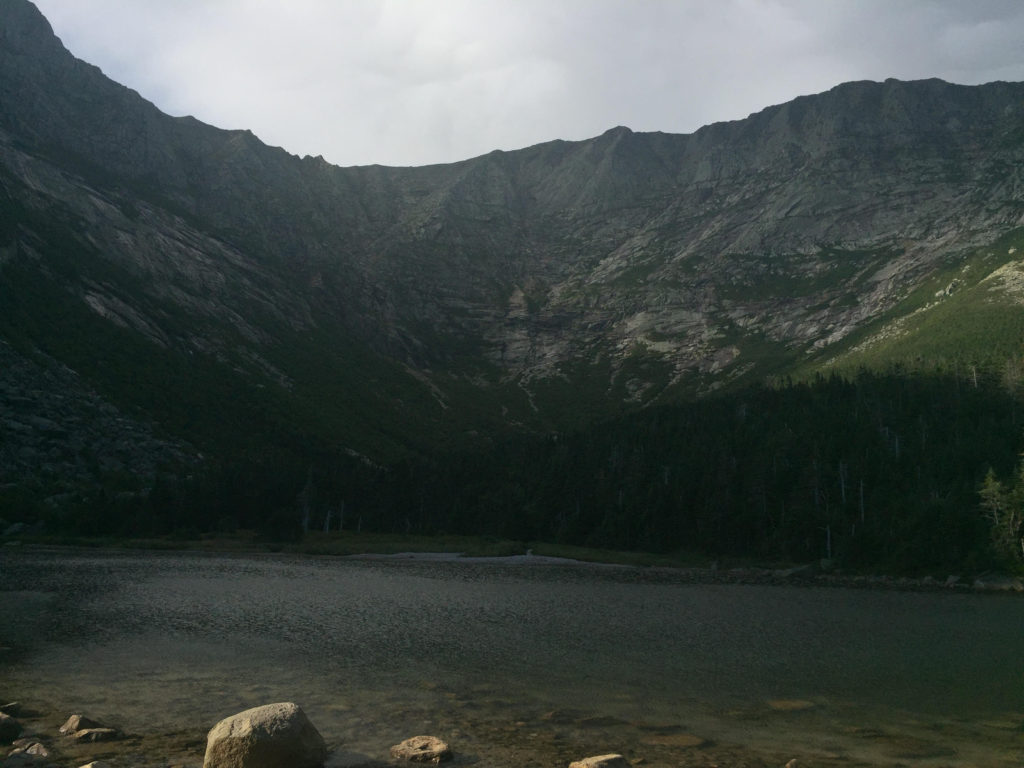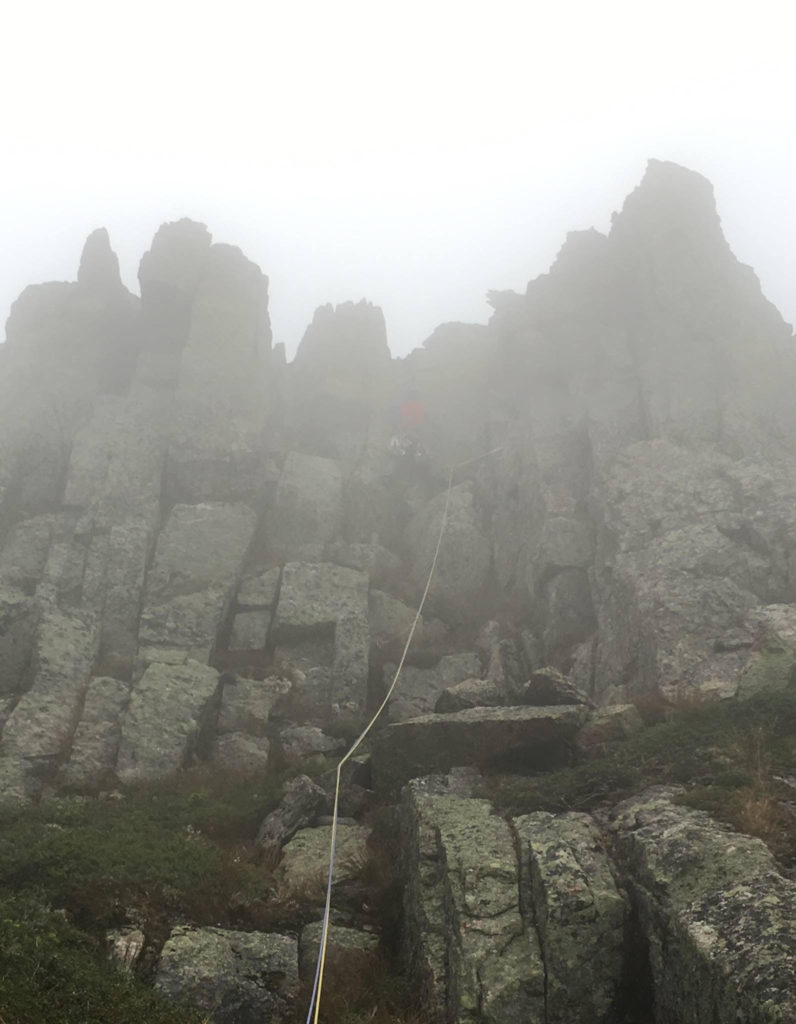CONTRIBUTION FROM RYAN GIBBS
No matter what sport you pursue in the mountains, self awareness and acceptance of your ability is critical to keeping you safe in the mountains. This philosophy has kept me safe and whole (for the most part) my entire life.
Rock climbing has never been my strength. I was first introduced to the sport by friends in 8th grade. Despite only being indoors, I was terrified of the heights and I was no boy scout when it came to knots. The concept was foreign, the movement unnatural, but still my heart told me to push on. I went on a week long climbing camp through the YMCA in Waterville, ME and learned a lot. I was young, afraid as much as ever after experiencing rock outdoors, and without a consistent mode of transportation, set aside rock climbing for pursuits I could do on my own power.

South Basin from Chimney Pond-The approach follows the center most gully to start.
Over the years Id try rock climbing on and off after pressure from friends, but it never gave me the sheer joy and satisfaction skiing or mountain biking did. It wasn’t until I started getting into more involved ski mountaineering objectives that the light switch turned on and I said to myself if you want to ski the lines of your dreams you need to sack up and climb reasonably hard. There is a reason certain lines on the east coast have never been skied, or only get skied a few times a decade by a quiet unassuming ethereal ghost you never hear about.These objectives take years of preparation, focus, willpower, an enormous skill set, willingness to suffer, and the balls to make it happen when the conditions are right. But I digress.

Topping out on the Knife’s Edge and headed into the mist.
When I decided I was going to commit to becoming a somewhat respectable climber I put my mind to it and started going to the gym. I went on a Friday and managed that Sunday to get into a fluke ski accident at Wildcat in NH. I broke my right hand’s 1st and 5th metacarpal badly enough it would take 7 permanently affixed screws to bring them back to a sustainable strength. It didn’t keep me from skiing, but it wasn’t until 4 months later I got the OK to start climbing on it. It doesn’t make crack climbing very fun.
Indoor climbing is a necessary evil for me. The whole purpose of climbing was a means to an end to enable me to access terrain not attainable otherwise. Once I started digging in deeper I found an enjoyment in climbing I honestly hadn’t thought possible. What I really crave in all my interests is adventure, so naturally I have gravitated towards backwoods adventure and alpine climbing. I was amazed and inspired by the amount of climbs out there still yet to be done and many unrepeated.
Fast forward a year feeling stronger on rock and hungry for more adventure I set off for an obscure route on Katahdin. Its probably only seen a half a dozen visits ever and is naturally a crack climb. The approach to the climb involves some committing 4th and 5th class moves depending what route you take. I liked a more direct start that is normally wet, but after a dry year was mostly free of water, after all we were here to climb. We discussed simuling the terrain as it was well within our limits, only 5.5 mostly less, but there was a move 15′ off the ground I was leery about simul climbing. We opted it would be quick enough to rope up and pitch it out quickly. The first pitch went fast and could definitely have been simuled comfortably. This put us in a stance below an awkward brushy corner and traverse, leading to some slabby moves up to an offwidth crack to gain the headwall. It was easy ground, but these moves and exposure warranted keeping the ropes out and leaving the approach shoes on, after all we had hiking to do before we got to our climb. I lead up through the brush and traversed. The gear was good and where I wanted it until I hit the slab part. This section clearly remained wet or damp for a significant portion of the year and was slick. I managed to find a shallow flake that was solid to put a 0.3 BD C4 cam in before committing to the slabby moves leading to the offwidth. It wasn’t perfect, but was good enough, this is the alpine after all. The next 3 moves were a bit awkward and greasy. I stepped high, my foot on a micro edge and just as I put my weight on it my foot blew. I began to slide down the steep slab. My last pro only 5 or 6 feet below, but there was a small terraced ledge that capped a big overhang I would most likely clip my foot on if I whipped. I relaxed and focused on watching where my feet were. Unfortunately these split seconds are never enough time to change much, my foot managed to go behind one of the double ropes, because the traverse and how I slipped managed to get in a bad position. Suddenly I stopped. I was stunned I had stopped so quickly as I’d imagined it to be so much worse. Confused I looked about and noticed the roped wasn’t even taught yet. I looked up only to see that my quickdraw had somehow managed to slide through the wrist closure of my Suunto Ambit 3. The wrist strap held and didn’t even jar my shoulder that much. I lifted myself up, unhooked myself, and climbed down a move to the small ledge. I dusted myself off and look in amazement at my partner. The fall might not have been bad, but I’d never taken a whip on gear. That had to be the weirdest whip ever. I felt lucky and bewildered about the nature of my catch, but there wasn’t time to think about that there was climbing to be had! I committed to the move again, grovelled up an easy, but awkward 7″ offwidth, and set up a belay once I hit the top of the headwall.
I have had the philosophy of climbing well within my limits on both rock and ice. I want every move to feel dialed when I do them climbing on gear. Because of my self awareness to not simulclimb these pitches we both came out of the day unscathed, (well except for my ego, after all it was only a 5.5 move)

 We are proud to work with the Department of Agriculture, the White Mountain National Forest and the Androscoggin Ranger District where we are authorized outfitter guides.
We are proud to work with the Department of Agriculture, the White Mountain National Forest and the Androscoggin Ranger District where we are authorized outfitter guides.
